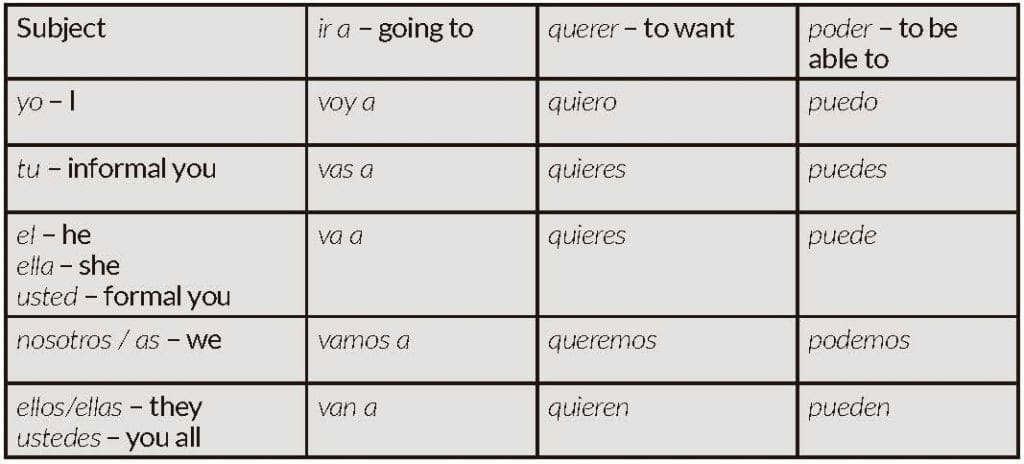
Shortcuts to Speaking Spanish
Shortcuts to Speaking Spanish: Making mistakes and stumbles is part of the journey. On the road to language fluency, the most important step is actually speaking. It is also the hardest thing to do. For a combination of reasons, we get tongue tied when trying to communicate in a foreign language. Between the fear of sounding like a fool and the mind-boggling complexity of verb conjugation, most people give up before they begin.
In truth, the key to fluid speech lies in creating your own mental database containing whatever you DO know already. This is sure to allow for more accelerated advancement in speaking Spanish. Here are some shortcuts to speaking Spanish that will help you start talking today.
Here are
some shortcuts
to help you start talking today.

1. Conjugation is not necessary and comes naturally
Don’t try to conjugate right away. Learn phrases or use the verb in its base form; the infinitive. Learn as many verbs as you can and use them in their rudimentary form. It’s all about simple sentences with a subject, a verb and a time marker.
Example: Yo querer comer — I to want to eat no.
It might sound silly to you, but the listener understands and you get your point across. The more you immerse yourself in the language, the more the language will fall into place.
2. Hay and Hay que
Here is a great little set of words that you can attach to your verbs and really start communicating. Hay means “there is” or “there are” and Hay que means “one must.”
Hay can be combined with objects and inflected as a question. Then you start finding out about all those things you have been looking for in stores.
Example: Hay aguacates? — Are there avacados?
Hay que can be combined with a verb and you are getting things done. It can be used when telling workers or helpers to do something you need them to do.
Example: Hay que limpiar la cocina. — The kitchen needs cleaning.
3. Ir a
This little set of words allows you get moving and get people moving. Ir a literally means “to go to” but is translated as “going to.”
You can tack it on to any verb in its base form and you have a sentence. Learning to conjugate ir is pretty simple so you can start forming sentences.
Example: Yo voy a comer ahora — I am going to eat now.
You can add it to a location.
Example: Vamos a la playa! — We are going to the beach.
4. The conditional
This little trick is pretty amazing. The conditional is the word “would” as in “I would go to eat.” In Spanish the conditional is used to soften commands and requests, so you can use it whenever you are out to eat or shopping. All you do is add ia to the end of a base verb and you just added the word “would.”
Examples: Me gustaria comer — I would like to eat.
Abriria la puerta? — Would you open the door?
5. Helper verb
Instead of learning all Spanish word conjugations, it is easier to learn a couple of “helper” verbs. These can be added to a base verb to make sentences.
Two examples: querer — “to want” and poder — “to be able to”
These are two great words to learn to conjugate and then start forming real sentences.
6. No need for question words
Asking questions in Spanish does not need a question word, such as “do” in English. You just make it sound like a question and you are good to go.
Your road to taking shortcuts to speaking Spanish might include many and all possible paths you take. There is no one way or right way, just your way.
The only certainty is that you will never speak unless you start speaking in the real world. Making mistakes and stumbles is part of the journey, and a very necessary aspect of learning.
A rule of thumb when trying to speak is to ask yourself, “What CAN I say?” instead of asking your brain to translate some complex concept into Spanish. Keep it simple and rudimentary. Learn these tips to get out there and talk.
Spanish Pronunciations: Vowels and Consonants
Spanish – Great minds think alike
Spanish – A dash of Pura Vida
Spanish – Step up your game
Spanish – Leveling Up, the 20/90 Challenge
Spanish- Tips for a New Year of Language Learning
Spanish – Relax, Engage, Learn
Spanish – Banter, a pura vida life skill
Spanish – Here’s looking at you, kid
Spanish – Yearning for Learning
Spanish – Seven Motivating Reasons to Start Learning today
Spanish – Verbs to live by
Spanish – Beware of false friends
Breaking the barriers of learning Spanish
